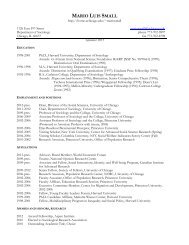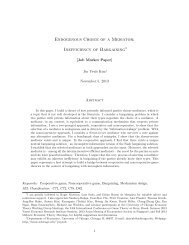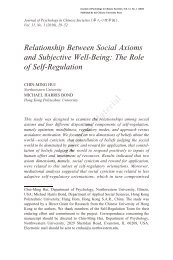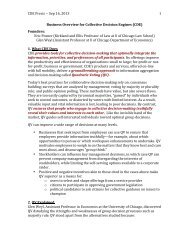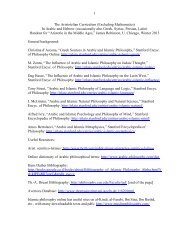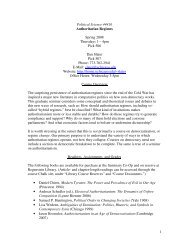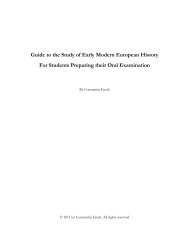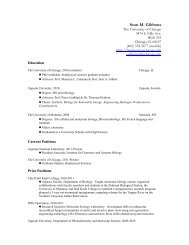Convergence Between Black Immigrants and Black Natives Across ...
Convergence Between Black Immigrants and Black Natives Across ...
Convergence Between Black Immigrants and Black Natives Across ...
Create successful ePaper yourself
Turn your PDF publications into a flip-book with our unique Google optimized e-Paper software.
with natives, possibly opening themselves up to discrimination. A confounding factor is the well-established<br />
fact that there is a earnings penalty for immigrants followed by a rise in earnings roughly proportional to the<br />
time spent in the US. In order to avoid dealing with the earnings penalty, the regressions control for time<br />
spent in the US <strong>and</strong> only focus on immigrants who have been in the US for 10 years or more. 18<br />
Immigrant children who get exposed to second languages during childhood generally achieve higher<br />
second language proficiency than those beginning as adults (Krashen et al. 2011). Since many African <strong>and</strong><br />
Caribbean immigrants come from countries where English is one of the official languages, accent <strong>and</strong> dialect<br />
become more important than language proficiency. Many studies link the beginning of puberty to accent<br />
acquisition; in other words, immigrants who arrive before puberty are much more likely to sound native than<br />
immigrants who arrive after. Since language proficiency <strong>and</strong> ease of assimilation decline monotonically with<br />
age of immigration, these two forces suggest a negative relation between age of immigration <strong>and</strong> earnings.<br />
Positive forces such as self-selection <strong>and</strong> motivation due to hardship forged by life experiences in the source<br />
country are counteracting forces.<br />
Figures 6a <strong>and</strong> 6b plot the coefficients on age of immigration by race for men <strong>and</strong> women from the<br />
following regression:<br />
ln(Earn)=l s + h t +<br />
M<br />
Â<br />
m=1<br />
b 1m m + b 2 Pot. Exp it + b 3 Pot Exp 2 it +<br />
4<br />
Â<br />
k=1<br />
b 4k School kit + b 5 YrsUSA it + e ismt (1)<br />
where i denotes the individual, s denotes the state of residence, m denotes the age at arrival in the US,<br />
t is the survey year, b 2 <strong>and</strong> b 3 capture labor market experience, the b 4k s capture different schooling levels<br />
(high school, some college, college, more than college), <strong>and</strong> b 5 accounts for the increase in earnings due<br />
to increased time spent in the US. Earnings are adjusted to all be in 2010 dollars. Each regression is run<br />
separately for different races <strong>and</strong> ethnicities <strong>and</strong> the control group are natives of the same group.<br />
For Hispanics <strong>and</strong> Asians, the immigrant premium monotonically declines with age of immigration. For<br />
whites <strong>and</strong> blacks, however, things look different. The premium actually increases until the age of 15 <strong>and</strong><br />
then starts to fall but never to the level of Hispanics <strong>and</strong> Asians. This is well past the average begin of<br />
puberty for boys (11-12) <strong>and</strong> girls (10-11). What could explain the difference between the evolution of age<br />
of immigration effects for these groups? Perhaps, a foreign accent for blacks <strong>and</strong> to a lesser extent for whites<br />
serves as a benefit in the labor market. <strong>Black</strong> native men have certain stereotypes attached to them that can<br />
be a disadvantage in the labor market. <strong>Black</strong> men who arrived past the age of 11 or 12 likely sound different<br />
than natives <strong>and</strong> thus can distinguish themselves from black natives in the labor market. The discrimination<br />
explanation is difficult to distinguish from assimilation. Potentially, blacks who immigrate later assimilate<br />
to a lesser degree with black natives, a group that generally falls behind whites in education <strong>and</strong> income<br />
18 Due to small sample sizes individuals are pooled in three years bins by age of immigration. For example, individuals at the 15<br />
year mark were between 14 <strong>and</strong> 16 years old when they arrived in the US. The figures are cut off at age 40 due to subsequent sampling<br />
noise with small bin sizes. The sample is restricted to the 2000 census <strong>and</strong> the 2001-2011 ACS, since pre-2000, year of immigration<br />
was only recorded in bracketed form.<br />
10



